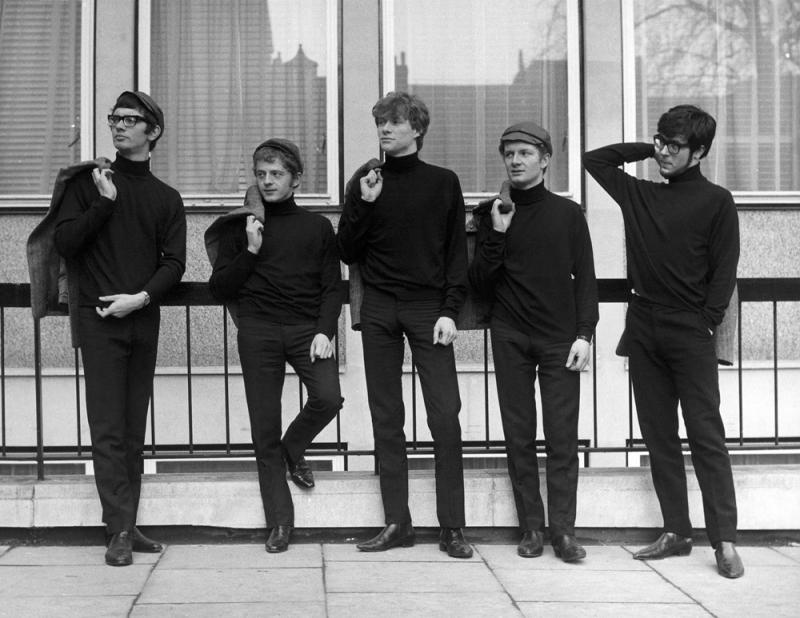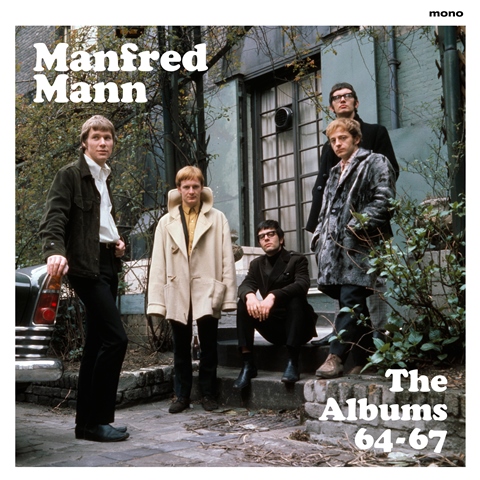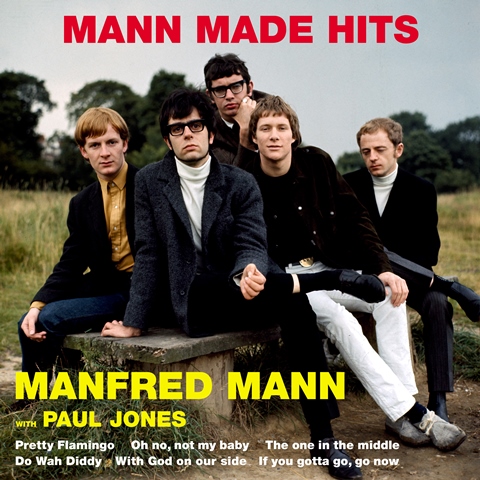Reissue CDs Weekly: Manfred Mann | reviews, news & interviews
Reissue CDs Weekly: Manfred Mann
Reissue CDs Weekly: Manfred Mann
‘The Albums ‘64 –‘67’: the first four HMV LPs from the jazz-pop-R&B stylists in a box

Dress each of the band in the same clothes. Stand them in a line outside the EMI headquarters building on Manchester Square. Get the taller ones with glasses to stand at either end of the row. Put the other taller one in the middle. Have the pair of less tall ones – who could be twins – stand between the taller ones. Symmetry and uniformity duly achieved, take the promotional photograph.
The picture seen above was used as the cover of the debut EP by Manfred Mann (pictured below right), issued in the wake of their first hit single “5-4-3-2-1”. It was helped into the charts by being chosen as the opening theme for the weekly pop show Ready Steady Go! The band, named after its pseudonymous keyboard player and under the guidance of future David Bowie manager Kenneth Pitt, were now pop stars.
 But look at the back of the 5-4-3-2-1 EP. The breathless liner notes say “each musician is highly trained in theory and experienced in performance. Before turning to the R&B idiom the group played a very distinctive brand of modern jazz.” Drummer Mike Hugg is credited as also playing vibes. Mike Vickers contributed alto sax, flute and guitar. Although it wasn’t said, two of the tracks – “Why Should We Not?” and “Cock-a-Hoop” – featured bassist Dave Richmond, who had left before “5-4-3-2-1”. He was replaced by Tom McGuinness. The South-Africa-born Michael Lubowitz aka Manfred Mann had studied at Juilliard. Less than a year earlier, they had been the Mann Hugg Blues Brothers. Neither the EP or the photograph told the full story. Symmetry and uniformity? Not a bit of it.
But look at the back of the 5-4-3-2-1 EP. The breathless liner notes say “each musician is highly trained in theory and experienced in performance. Before turning to the R&B idiom the group played a very distinctive brand of modern jazz.” Drummer Mike Hugg is credited as also playing vibes. Mike Vickers contributed alto sax, flute and guitar. Although it wasn’t said, two of the tracks – “Why Should We Not?” and “Cock-a-Hoop” – featured bassist Dave Richmond, who had left before “5-4-3-2-1”. He was replaced by Tom McGuinness. The South-Africa-born Michael Lubowitz aka Manfred Mann had studied at Juilliard. Less than a year earlier, they had been the Mann Hugg Blues Brothers. Neither the EP or the photograph told the full story. Symmetry and uniformity? Not a bit of it.
It’s the same with everything they issued for EMI’s HMV imprint. The pop sensibility which took them to the top of the US charts in Autumn 1964 with “Do Wah Diddy” battled it out with the serious, jazz-inclined, muso outlook. Nowhere is this more apparent than on their albums from the period.
 The Albums ‘64 –‘67 is new box set of vinyl repressings of the four Manfred Mann LPs HMV issued in the Sixties. The Five Faces of Manfred Mann (originally issued in September 1964) and Mann Made (October 1965) were conceived and recorded as albums. Mann Made Hits (September 1966) and Soul of Mann (January 1967) were compiled by HMV from previously issued material after singer Paul Jones left the band in July 1966 (Mike Vickers had left in October 1965). In case there was any confusion with the new, Mike d’Abo-fronted Manfred Mann, the sleeve of Mann Made Hits credited the album to “Manfred Mann With Paul Jones”.
The Albums ‘64 –‘67 is new box set of vinyl repressings of the four Manfred Mann LPs HMV issued in the Sixties. The Five Faces of Manfred Mann (originally issued in September 1964) and Mann Made (October 1965) were conceived and recorded as albums. Mann Made Hits (September 1966) and Soul of Mann (January 1967) were compiled by HMV from previously issued material after singer Paul Jones left the band in July 1966 (Mike Vickers had left in October 1965). In case there was any confusion with the new, Mike d’Abo-fronted Manfred Mann, the sleeve of Mann Made Hits credited the album to “Manfred Mann With Paul Jones”.
While it’s impossible to know what anyone buying The Five Faces of Manfred Mann after “5-4-3-2-1” and “Do Wah Diddy” had charted thought of the album, it’s a fair bet there may have been some confusion. The US-influenced pop they had taken into the singles countdown was absent. Instead of happy-go-lucky ditties, there were fine, swinging covers of “Smokestack Lightning", “Down the Road Apiece” and “Bring it to Jerome”. The originals were mostly jazz influenced and the album loosely placed the band in the centre of a venn diagram delineated by The Animals, Graham Bond and Georgie Fame.
 With the exception of the glutinous “Hi Lili, Hi Lo” and a lumpy, overwrought “Stormy Monday Blues”, it was the same with Mann Made. Tom McGuinness contributed a track titled “L.S.D.” which probably did not refer to pounds, shillings and pence. As the different Pretty Things song of the same name was issued as a B-side in April 1966, Manfred Mann had the privilege of being Britain’s first pop group to (seemingly) explicitly reference the psychedelic drug. The album’s liner notes had the punkish pay off “These are our sounds. Take it or leave it.” The implication was that the hit singles – which by then included the Dylan cover “If You Gotta Go, Go Now” – were not “our sounds”.
With the exception of the glutinous “Hi Lili, Hi Lo” and a lumpy, overwrought “Stormy Monday Blues”, it was the same with Mann Made. Tom McGuinness contributed a track titled “L.S.D.” which probably did not refer to pounds, shillings and pence. As the different Pretty Things song of the same name was issued as a B-side in April 1966, Manfred Mann had the privilege of being Britain’s first pop group to (seemingly) explicitly reference the psychedelic drug. The album’s liner notes had the punkish pay off “These are our sounds. Take it or leave it.” The implication was that the hit singles – which by then included the Dylan cover “If You Gotta Go, Go Now” – were not “our sounds”.
By the time Mann Made was released, Paul Jones had told the band he was leaving. He had, remarkably, given a year’s notice. After switching to the Fontana label, they pushed on with Mike d’Abo and charted with “Pretty Flamingo” and “Just Like a Woman”, another Dylan cover. HMV did what record labels do and capitalised on what they had lost by issuing the Mann Made Hits and Soul of Mann compilations.
 Mann Made Hits was singles-heavy, has a large head-shot of Jones on the rear of its cover (he had just charted with the peppy “High Time”) and is a great listen – it is the pop-oriented album the band were congenitally unable to make. On the other hand, Soul of Mann is an album they could have made: a collection of their blues and jazz-oriented instrumentals. Despite being cash-ins, each album is a treat.
Mann Made Hits was singles-heavy, has a large head-shot of Jones on the rear of its cover (he had just charted with the peppy “High Time”) and is a great listen – it is the pop-oriented album the band were congenitally unable to make. On the other hand, Soul of Mann is an album they could have made: a collection of their blues and jazz-oriented instrumentals. Despite being cash-ins, each album is a treat.
However, The Albums ‘64–’67 is not strictly about the quality of the music or how it first reached the world. The four albums are nicely packaged in a lift-off-lid box and each is remastered from the mono master tapes. They all sound superb. A comparison of the new The Five Faces of Manfred Mann and Mann Made to original pressings suggests that a light fog obscuring the music has cleared. There is more dynamism, immediacy and punch than ever. The package also includes a DVD of recently filmed footage with Mike Hugg, Paul Jones, Manfred Mann and Tom McGuinness reminiscing and a 12-inch-square print of a picture of the band looking very moody. The Albums ‘64–’67 is limited to 2000 copies. Each album is also reissued individually on CD.
The Albums ‘64–’67 sells for £100 so is, obviously, no spontaneous purchase. Decent shape first pressings of each album can be found for £10 to £15. As to which to own? That’s moot. Most interested parties probably bought copies years ago for much less than £100 and, improved audio and extras notwithstanding, may not wish to fork out again. Setting this alongside a sense that the hipster vinyl crowd may not be too interested in Manfred Mann, it is hard to see The Albums ‘64–’67 as an easy sell. Nonetheless, all four albums contain some of the best popular music Britain produced during the Sixties.
- Next Week: Muslims and Christians – a collection of previously lost recordings by Sudan's Kamal Keila
Share this article
The future of Arts Journalism
You can stop theartsdesk.com closing!
We urgently need financing to survive. Our fundraising drive has thus far raised £49,000 but we need to reach £100,000 or we will be forced to close. Please contribute here: https://gofund.me/c3f6033d
And if you can forward this information to anyone who might assist, we’d be grateful.

Subscribe to theartsdesk.com
Thank you for continuing to read our work on theartsdesk.com. For unlimited access to every article in its entirety, including our archive of more than 15,000 pieces, we're asking for £5 per month or £40 per year. We feel it's a very good deal, and hope you do too.
To take a subscription now simply click here.
And if you're looking for that extra gift for a friend or family member, why not treat them to a theartsdesk.com gift subscription?
more New music
 Solar Eyes, Hare & Hounds, Birmingham review - local lads lay down some new tunes for a home crowd
Psychedelic indie dance music marinated in swirling dry ice
Solar Eyes, Hare & Hounds, Birmingham review - local lads lay down some new tunes for a home crowd
Psychedelic indie dance music marinated in swirling dry ice
 The Lemonheads' 'Love Chant' is a fine return to form
Evan Dando finally gets back in the saddle with an album of new tunes
The Lemonheads' 'Love Chant' is a fine return to form
Evan Dando finally gets back in the saddle with an album of new tunes
 Music Reissues Weekly: Evie Sands - I Can’t Let Go
Diligent, treasure-packed tribute to one of Sixties’ America’s great vocal stylists
Music Reissues Weekly: Evie Sands - I Can’t Let Go
Diligent, treasure-packed tribute to one of Sixties’ America’s great vocal stylists
 'Deadbeat': Tame Impala's downbeat rave-inspired latest
Fifth album from Australian project grooves but falls flat
'Deadbeat': Tame Impala's downbeat rave-inspired latest
Fifth album from Australian project grooves but falls flat
 Heartbreak and soaring beauty on Chrissie Hynde & Pals' Duets Special
The great Pretender at her most romantic and on the form of her life
Heartbreak and soaring beauty on Chrissie Hynde & Pals' Duets Special
The great Pretender at her most romantic and on the form of her life
 The Last Dinner Party's 'From the Pyre' is as enjoyable as it is over-the-top
Musically sophisticated five-piece ramp up the excesses but remain contagiously pop
The Last Dinner Party's 'From the Pyre' is as enjoyable as it is over-the-top
Musically sophisticated five-piece ramp up the excesses but remain contagiously pop
 Moroccan Gnawa comes to Manhattan with 'Saha Gnawa'
Trance and tradition meet Afrofuturism in Manhattan
Moroccan Gnawa comes to Manhattan with 'Saha Gnawa'
Trance and tradition meet Afrofuturism in Manhattan
 Soulwax’s 'All Systems Are Lying' lays down some tasty yet gritty electro-pop
Belgian dancefloor veterans return to the fray with a dark, pop-orientated sound
Soulwax’s 'All Systems Are Lying' lays down some tasty yet gritty electro-pop
Belgian dancefloor veterans return to the fray with a dark, pop-orientated sound
 Music Reissues Weekly: Marc and the Mambas - Three Black Nights Of Little Black Bites
When Marc Almond took time out from Soft Cell
Music Reissues Weekly: Marc and the Mambas - Three Black Nights Of Little Black Bites
When Marc Almond took time out from Soft Cell
 Album: Mobb Deep - Infinite
A solid tribute to a legendary history
Album: Mobb Deep - Infinite
A solid tribute to a legendary history
 Album: Boz Scaggs - Detour
Smooth and soulful standards from an old pro
Album: Boz Scaggs - Detour
Smooth and soulful standards from an old pro
 Emily A. Sprague realises a Japanese dream on 'Cloud Time'
A set of live improvisations that drift in and out of real beauty
Emily A. Sprague realises a Japanese dream on 'Cloud Time'
A set of live improvisations that drift in and out of real beauty

Add comment